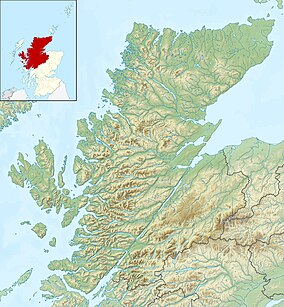Invereshie and Inshriach National Nature Reserve
| Invereshie and Inshriach National Nature Reserve | |
|---|---|
Scots pines below the crags of Creag Mhigeachaidh | |
| Location | Highland, Scotland |
| Coordinates | 57°05′51″N 3°51′08″W / 57.097400°N 3.852229°W |
| Area | 37.3 km2 (14.4 sq mi)[2] |
| Designation | NatureScot |
| Established | 2007[1] |
| Owner | NatureScot & Forestry and Land Scotland |
| Invereshie and Inshriach National Nature Reserve | |
Invereshie and Inshriach (
There are no waymarked trails at the reserve; however, several paths do run through it, starting from Coire Ruadh or Achlean in Glen Feshie. The paths through the reserve are regularly used by hillwalkers to access the summit of Sgòr Gaoith.[3][6]
Flora and fauna
Probably the most significant habitat at the reserve is the Caledonian Forest, which covers the landscape between about 250-630 m above sea level.
The woodland is home to many species of bird which are otherwise rare or uncommon, such as
The streams and lochs of the forest are ideal for
History

Caledonian Forest first became established in Invereshie and Inshriach at the end of the last ice age. Although humans are known to have lived in the area since at least the Bronze Age, until around the mid-18th century the forest remained largely intact, with only small-scale felling of trees for domestic use and localised rough grazing.[14]
As the population of Scotland grew during the second half of the 18th century more people began to move into the glens of the Cairngorms, including Glen Feshie. Land began to be cleared for agriculture, and this process accelerated during the
Demand for timber increased again during the
Following a review of the Cairngorms NNR in 2006 it was decided that the NNR should be broken up into separate, smaller reserves that reflected existing management units.[14] The new Invereshie and Inshriach NNR was declared in September 2007, combining the SNH-owned Invereshie estate with part of the neighbouring Inshriach Forest, which had been previously outwith the Cairngorms NNR.[18]
Conservation designations
In addition to being a national nature reserve (NNR), Invereshie and Inshriach lies within a number of other protected areas of Scotland. It forms part of the Cairngorms Site of Special Scientific Interest (SSSI),[19] the Cairngorms Special Protection Area (SPA),[20] and the Cairngorms Special Area of Conservation (SAC).[21] It also lies within the Cairngorms National Park.[22] The Invereshie and Inshriach NNR is classified as a Category IV protected area by the International Union for Conservation of Nature.[1]
References
Citations
- ^ a b c "Invereshie and Inshriach". Protected Planet. Retrieved 14 February 2021.
- ^ "Invereshie and Inshriach NNR". NatureScot. Retrieved 16 September 2020.
- ^ a b "Visit Invereshie and Inshriach NNR" (PDF). Scottish Natural Heritage. 2013. Retrieved 19 February 2019.
- ^ The Story of Invereshie and Inshriach National Nature Reserve. p. 1.
- ^ The Story of Invereshie and Inshriach National Nature Reserve. p. 29.
- ISBN 9780907521945.
- ^ The Story of Invereshie and Inshriach National Nature Reserve. p. 7.
- ^ Nick Kempe (2018-05-03). "SNH's plans for the Invereshie National Nature Reserve – gardening in the Cairngorms?". parkswatchscotland. Retrieved 2019-02-25.
- ^ The Story of Invereshie and Inshriach National Nature Reserve. p.p. 7-11.
- ^ The Story of Invereshie and Inshriach National Nature Reserve. p. 15.
- ^ The Story of Invereshie and Inshriach National Nature Reserve. p. 14.
- ^ The Story of Invereshie and Inshriach National Nature Reserve. p. 12.
- ^ a b The Story of Invereshie and Inshriach National Nature Reserve. p. 13.
- ^ a b c The Story of Invereshie and Inshriach National Nature Reserve. p. 19.
- ^ a b The Story of Invereshie and Inshriach National Nature Reserve. p. 20.
- ^ The Story of Invereshie and Inshriach National Nature Reserve. p. 21.
- ^ The Story of Invereshie and Inshriach National Nature Reserve. p. 23.
- ^ The Story of Invereshie and Inshriach National Nature Reserve. p. 26.
- ^ "Cairngorms SSSI". NatureScot. Retrieved 16 September 2020.
- ^ "Cairngorms SPA". NatureScot. Retrieved 16 September 2020.
- ^ "Cairngorms SAC". NatureScot. Retrieved 16 September 2020.
- ^ "Cairngorms National Park". NatureScot. Retrieved 16 September 2020.
Bibliography
- "The Story of Invereshie and Inshriach National Nature Reserve" (PDF). Scottish Natural Heritage. 2009. Retrieved 19 February 2019.
External links
- Scotland's National Nature Reserves
- Invereshie and Inshriach – Forestry and Land Scotland

